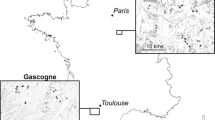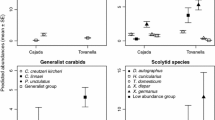Abstract
Successional processes in forest gaps created by tree falls are often considered a principal mechanism maintaining species diversity within forests. Although insects are important as mediators of forest recovery processes, there have been few observations of how they differ between forest gaps and non-gaps across latitudes. Here we tested the impacts of gap habitat on beetle assemblage composition at three locations spanning sub-tropical and tropical biomes (28°S, 16°S, 5°N: Lamington and Daintree in Australia, and Danum in Borneo). Beetles were collected by flight interception traps and sorted to family and feeding guilds. Despite clear differences in environmental conditions between gaps and non-gaps at all three location, we found weak and inconsistent differences in beetle family and feeding guild composition across a latitudinal gradient. PERMANOVA results showed no significant differences in beetle family and feeding guild composition between gaps and non-gaps. For beetle families, however, the interaction effect (between gap vs. non-gap treatment and location) was significant. Post-hoc analysis and NMDS ordinations showed significant and clear separation of family assemblages between gaps and non-gaps within the Danum samples but not within samples from either the Lamington or Daintree sites. Using IndVal, when all three locations were combined, Chrysomelidae and Tenebrionidae were found to be indicators for gaps and Scarabaeinae and Leiodidae for non-gaps. Analysed separately, gap indicators were only Chrysomelidae at Daintree, whereas non-gap indicators were Scarabaeinae at Lamington, Scarabaeinae, all other Scarabaeidae, Anthicidae, Scydmaeninae, and Hybosoridae at Danum. We suggest the scale of changes in insect composition and richness with the creation of a natural light gap in forests contrast with those resulting from anthropogenic disturbance such as logging and clearing of forests and the greater adaptability of forests to small-scale changes rather than large-scale changes.


Similar content being viewed by others
References
Anderson M, Gorley RN, Clarke RK (2008) Permanova + for primer: guide to software and statistical methods. Plymouth marine laboratory, Plymouth
Bouget C (2005a) Short-term effect of windstorm disturbance on saproxylic beetles in broadleaved temperate forests: Part I: do environmental changes induce a gap effect? For Ecol Manag 216:1–14
Bouget C (2005b) Short-term effect of windstorm disturbance on saproxylic beetles in broadleaved temperate forests: Part II. Effects of gap size and gap isolation. For Ecol Manag 216:15–27
Bouget C, Duelli P (2004) The effects of windthrow on forest insect communities: a literature review. Biol Conserv 118:281–299. doi:10.1016/j.biocon.2003.09.009
Brokaw NV (1982) The definition of treefall gap and its effect on measures of forest dynamics. Biotropica 14(2):158–160
Brokaw N, Busing RT (2000) Niche versus chance and tree diversity in forest gaps. Trends Ecol Evol 15:183–188
Brown N, Jennings S (1998) Gap-size niche differentiation by tropical rainforest trees: a testable hypothesis or a broken-down bandwagon dynamics of tropical communities. Blackwell, Oxford, pp 79–94
Burbidge NT (1960) The phytogeography of the Australian region. Aust J Bot 8:75–211
Burslem D (2010) Smithsonian tropical research institute, center for tropical forest science http://www.ctfs.si.edu/site/Danum+Valley/
Chao A, Jost L (2012) Coverage-based rarefaction and extrapolation: standardizing samples by completeness rather than size. Ecology 93:2533–2547
Clarke K, Gorley R (2006) PRIMER version 6: user manual/tutorial PRIMER-E. Plymouth, UK, p 192
Connell JH (1978) Diversity in tropical rain forests and coral reefs. Science 199:1302–1310
Connell JH, Slayter RO (1977) Mechanisms of succession in natural communities and their role in community stability and organization. Am Nat 111:1119–1144
Denslow JS (1987) Tropical rainforest gaps and tree species diversity. Annu Rev Ecol Syst 18:431–451
Denslow JS, Ellison AM, Sanford RE (1998) Treefall gap size effects on above-and below-ground processes in a tropical wet forest. J Ecol 86:597–609
Dufrêne M, Legendre P (1997) Species assemblages and indicator species: the need for a flexible asymmetrical approach. Ecol Monogr 67:345–366
Evans AV, Bellamy CL, Watson LC (2000) An inordinate fondness for beetles. Univ of California Press, Los Angeles
Ewers RM et al (2015) Logging cuts the functional importance of invertebrates in tropical rainforest. Nat commun. doi:10.1038/ncomms7836
Feener DH Jr, Schupp EW (1998) Effect of treefall gaps on the patchiness and species richness of neotropical ant assemblages. Oecologia 116:191–201
Gibson L et al (2011) Primary forests are irreplaceable for sustaining tropical biodiversity. Nature 478:378–382. doi:10.1038/Nature10425
Grimaldi D, Engel MS (2005) Evolution of the insects. Cambridge University Press, New York
Grove SJ (2001) Extent and composition of dead wood in Australian lowland tropical rainforest with different management histories. For Ecol Manag 154:35–53
Grove SJ, Turton SM, Siegenthaler DT (2000) Mosaics of canopy openness induced by tropical cyclones in lowland rain forests with contrasting management histories in northeastern Australia. J Trop Ecol 16:883–894
Hammond PM (1990) Insect abundance and diversity in the Dumoga-Bone National Park, N. Sulawesi, with special reference to the beetle fauna of lowland rain forest in the Toraut region. In: Knight WJ, Holloway JD (eds) Insects and the rain forests of South East Asia (Wallacea). Royal Entomological Society, London, pp 197–254
Hammond PM (1994) Practical approaches to the estimation of the extent of biodiversity in speciose groups. Philos Trans R Soc Lond Ser B 345:119–136
Hammond PM, Kitching RL, Stork NE (1996) The composition and richness of the tree-crown coleoptera assemblage in an Australian subtropical forest. Ecotropica 2:99–108
Hazebroek HP, Adlin TZ, Sinun W, Reynolds G (2012) Danum valley: the rain forest. Natural History Publications (Borneo), Kota Kinabalu
Hill J, Hamer K, Tangah J, Dawood M (2001) Ecology of tropical butterflies in rainforest gaps. Oecologia 128:294–302
Houlihan PR, Harrison ME, Cheyne SM (2013) Impacts of forest gaps on butterfly diversity in a Bornean peat-swamp forest. J Asia-Pac Entomol 16:67–73
Hsieh T, Ma K, Chao A (2013) iNEXT online: interpolation and extrapolation (Version 1.0)[Software]
Hubbell SP (1999) Light-gap disturbances, recruitment limitation, and tree diversity in a neotropical forest. Science 283:554–557
Hubbell SP (2001) The unified neutral theory of biodiversity and biogeography (MPB-32), vol 32. Princeton University Press, Princeton
Hunt T et al (2007) A comprehensive phylogeny of beetles reveals the evolutionary origins of a superradiation. Science 318:1913–1916
Kitching RL (2013) Niches and neutrality: community ecology for entomologists Australian. J Entomol 52:1–7. doi:10.1111/aen.12015
Kitching RL The ecology of Australia’s wet tropics: proceedings of a symposium held at the University of Queensland, Brisbane August 25–27, 1986.(Symposium papers). In: Proceedings of the Ecological Society of Australia, 1988. Surrey Beatty and Sons
Laidlaw M, Olsen M, Kitching R, Greenway M Tree floristic and structural characteristics of one hectare of subtropical rainforest in Lamington National Park, Queensland. In: Proceedings of the Royal Society of Queensland, Royal Society of Queensland Inc., 91–105 2000
Laidlaw M, Kitching R, Goodall K, Small A, Stork N (2007) Temporal and spatial variation in an Australian tropical rainforest. Austral Ecol 32:10–20. doi:10.1111/j.1442-9993.2007.01739.x
Lawrence J, Newton A (1995) Biology, phylogeny, and classification of Coleoptera. In: Pakaluk J, Slipinski S (eds) Biology, phylogeny, and classification of Coleoptera. Museum i Zoologii PAN, Warzawa, pp 779–1066
Lawton RO, Putz FE (1988) Natural disturbance and gap-phase regeneration in a wind-exposed tropical cloud forest. Ecology 69(3):764–777
Lawton JH et al (1998) Biodiversity inventories, indicator taxa and effects of habitat modification in tropical forest. Nature 391:72–76
Levey DJ (1988) Tropical wet forest treefall gaps and distributions of understory birds and plants. Ecology 69(4):1076–1089
Molino J-F, Sabatier D (2001) Tree diversity in tropical rain forests: a validation of the intermediate disturbance hypothesis. Science 294:1702–1704
Newbery DM, Campbell E, Lee Y, Ridsdale C, Still M (1992) Primary lowland dipterocarp forest at Danum Valley, Sabah, Malaysia: structure, relative abundance and family composition. Philos Trans R Soc B 335:341–356
Nicotra AB, Chazdon RL, Iriarte SV (1999) Spatial heterogeneity of light and woody seedling regeneration in tropical wet forests. Ecology 80:1908–1926
Ødegaard F (2000) How many species of arthropods? Erwin’s estimate revisited. Biol J Linn Soc 71:583–597
Pardonnet S, Beck H, Milberg P, Bergman KO (2013) Effect of tree-fall gaps on fruit-feeding nymphalid butterfly assemblages in a Peruvian rain forest. Biotropica 45:612–619
Pearson TR, Burslem DF, Goeriz RE, Dalling JW (2003) Interactions of gap size and herbivory on establishment, growth and survival of three species of neotropical pioneer trees. J Ecol 91:785–796
Richards LA, Windsor DM (2007) Seasonal variation of arthropod abundance in gaps and the understorey of a lowland moist forest in Panama. J Trop Ecol 23:169–176
Schemske DW, Brokaw N (1981) Treefalls and the distribution of understory birds in a tropical forest. Ecology 62(4):938–945
Schnitzer SA, Carson WP (2001) Treefall gaps and the maintenance of species diversity in a tropical forest. Ecology 82:913–919
Schnitzer SA, Mascaro J, Carson WP (2008) Treefall gaps and the maintenance of plant species diversity in tropical forests tropical forest community ecology. Blackwell, Chichester, pp 196–209
Schulze CH et al (2004) Biodiversity indicator groups of tropical land-use systems: comparing plants, birds, and insects. Ecol Appl 14:1321–1333
SEARRP (2012) Danum valley field centre. http://www.searrp.org/danum-valley/. Accessed 13 Jan 2012
Sheil D (1999) Tropical forest diversity, environmental change and species augmentation: after the intermediate disturbance hypothesis. J Veg Sci 10:851–860
Shelly TE (1988) Relative abundance of day-flying insects in treefall gaps vs shaded understory in a neotropical forest. Biotropica 20:114–119
Stork NE, Grimbacher PS (2006) Beetle assemblages from an Australian tropical rainforest show that the canopy and the ground strata contribute equally to biodiversity. Proc R Soc B 273:1969–1975. doi:10.1098/rspb.2006.3521
Sugiura S, Yamaura Y, Tsuru T, Goto H, Hasegawa M, Makihara H, Makino SI (2009) Beetle responses to artificial gaps in an oceanic island forest: implications for invasive tree management to conserve endemic species diversity. Biodivers Conserv 18:2101–2118
Team RC (2014) R: a language and environment for statistical computing. Vienna, Austria: R Foundation for Statistical Computing 2014
Turton SM, Siegenthaler DT (2004) Immediate impacts of a severe tropical cyclone on the microclimate of a tropical rainforest canopy in northeast Australia. J Trop Ecol 20:583–586
van der Meer PJ, Sterck FJ, Bongers F (1998) Tree seedling performance in canopy gaps in a tropical rain forest at Nouragues French Guiana. J Trop Ecol 14:119–137
Whitmore TC (1984) Tropical rain forests of the Far East, vol 2. Clarendon Press/Oxford University Press, Oxford
Wright SJ, Muller-Landau HC, Schipper J (2009) The future of tropical species on a warmer planet. Conserv Biol 23:1418–1426
Acknowledgements
We thank the many volunteers who helped with fieldwork including Aaron Gee, Claire, Hayley Troupe, Nate Jaimeson and Tim McCaig. We also thank Dr. Arthur Chung, from the Sabah Biodiversity Centre, Danum Valley Field Centre, South-east Asia Rainforest Research Program (SEARRP) and James Cook University and Peter Byrnes at the Daintree Rainforest Observatory at Cape Tribulation. The Lamington Park Natural History Association kindly permitted use of their caravan at O’Reillys Rainforest Resort.
Author information
Authors and Affiliations
Corresponding author
Additional information
Communicated by Dirk Sven Schmeller.
This article belongs to the Topical Collection: Forest and plantation biodiversity.
Electronic supplementary material
Below is the link to the electronic supplementary material.
Rights and permissions
About this article
Cite this article
Watkins, E., Kitching, R.L., Nakamura, A. et al. Beetle assemblages in rainforest gaps along a subtropical to tropical latitudinal gradient. Biodivers Conserv 26, 1689–1703 (2017). https://doi.org/10.1007/s10531-017-1326-8
Received:
Revised:
Accepted:
Published:
Issue Date:
DOI: https://doi.org/10.1007/s10531-017-1326-8




